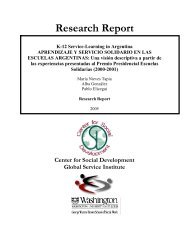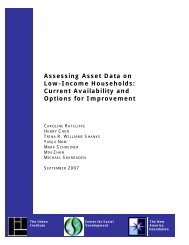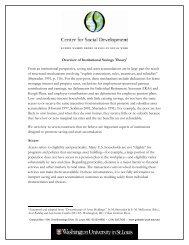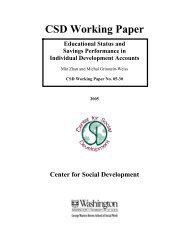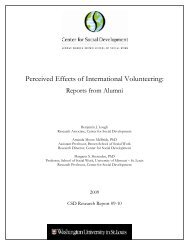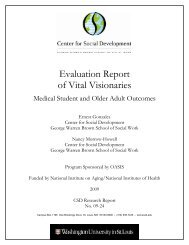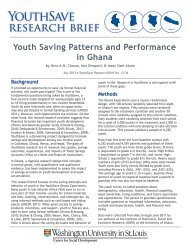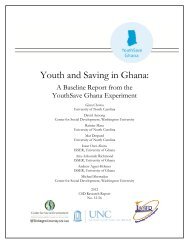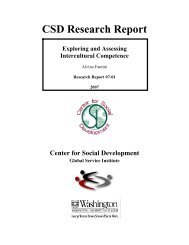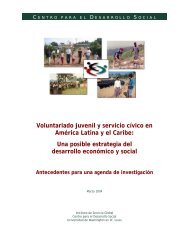Rediscovering social investment in developmental welfare state ...
Rediscovering social investment in developmental welfare state ...
Rediscovering social investment in developmental welfare state ...
You also want an ePaper? Increase the reach of your titles
YUMPU automatically turns print PDFs into web optimized ePapers that Google loves.
R E D I S C O V E R I N G S O C I A L I N V E S T M E N T I N D E V E L O P M E N T A L W E L F A R E S T A T E P O L I C I E S :<br />
B A C K T O T H E F U T U R E<br />
<strong><strong>in</strong>vestment</strong>- or ma<strong>in</strong>tenance-oriented on their own. Their effects are anticipated to occur as a result<br />
of the comb<strong>in</strong>ation of <strong>social</strong> policies.<br />
The central idea is that 1 + 1 is not always equal to 2 but may <strong>in</strong> fact be someth<strong>in</strong>g else greater than<br />
2. Policies may have both a discrete impact on poverty and labor market outcomes and a comb<strong>in</strong>ed<br />
nonadditive, nonl<strong>in</strong>ear impact that is greater for both aspects together than each separately. For<br />
<strong>in</strong>stance, cash transfers may be more likely to generate moral hazard when means tested or when<br />
overall expenditure is high, while moral hazard may be lessened if the program is universal or if<br />
expenditure levels are low. Alternatively, the total amount spent on <strong>in</strong>-k<strong>in</strong>d benefits may not be as<br />
salient as the relative proportion of <strong>in</strong>-k<strong>in</strong>d to universal benefits and where they are <strong>in</strong>vested.<br />
Comb<strong>in</strong><strong>in</strong>g cash benefits with means-tested benefits may result <strong>in</strong> lower uptake <strong>in</strong> <strong>developmental</strong>ly<br />
important areas. Reasons for low uptake <strong>in</strong>clude a lack of knowledge among potentially eligible<br />
people, reluctance to accept what may be perceived as charity, and the complex adm<strong>in</strong>istrative<br />
procedures <strong>in</strong>volved (Pestieau, 2006). If different benefits have different uptake or consumption<br />
characteristics, there may be costs associated with gaps <strong>in</strong> coverage or lost benefits attached to<br />
forgone future productivity. In this sense, certa<strong>in</strong> populations may be more likely to benefit from <strong>in</strong>k<strong>in</strong>d<br />
benefits than others.<br />
There are several <strong>in</strong>teractive effects that may be particularly important from a <strong>developmental</strong><br />
perspective. Just as the lowest rates of posttax/transfer poverty should be correlated with <strong>in</strong>dividual<br />
DWSPs, these policies are expected to positively <strong>in</strong>teract. Of central <strong>in</strong>terest is the <strong>in</strong>teraction<br />
between <strong>in</strong>-k<strong>in</strong>d and universal benefits. They are expected to have a stronger antipoverty effect<br />
together than either variable alone. The reason for suspect<strong>in</strong>g this <strong>in</strong>teraction is that they are<br />
believed to collectively have a stronger impact of guarantee<strong>in</strong>g consumption of resources that are<br />
<strong>in</strong>versely related to poverty (especially costly poverty) while m<strong>in</strong>imiz<strong>in</strong>g distortions. Of course, there<br />
could also be three-way <strong>in</strong>teractions among policy variables. For <strong>in</strong>stance, the negative effect of<br />
<strong>social</strong> expenditure on market poverty might be higher when comb<strong>in</strong>ed with universal and <strong>in</strong>-k<strong>in</strong>d<br />
benefits than alone.<br />
The assertion that distribution and production are <strong>in</strong>terrelated and that the former may positively<br />
impact the latter suggests that policy should be concerned about distribut<strong>in</strong>g more than <strong>in</strong>come (e.g.,<br />
forms of capital such as health, adaptability through education and tra<strong>in</strong><strong>in</strong>g, perceived mobility,<br />
opportunity via low <strong>in</strong>equality [e.g., Kaufmann, 2007], and the like). As suggested earlier, transfers<br />
<strong>in</strong>volve not only <strong>in</strong>come, resources, or commodities but also, if implicitly, wider capabilities, access,<br />
etc. <strong>in</strong> terms of the means by which they are delivered. It also suggests a focus on prevention. The<br />
conventional economic approach does not necessarily support these implications. Below, I briefly<br />
contrast assumptions of the standard economic approach with the <strong>social</strong> <strong>developmental</strong> approach<br />
and the types of policies each approach would support. I clarify the key economic underp<strong>in</strong>n<strong>in</strong>g<br />
observations that underlie DWSPs. (Refer to Johnson [2010] for a more extensive discussion of the<br />
economic logic of DWSPs.)<br />
The Economic Logic and Predictions of DWSPs<br />
I have argued that we need to expla<strong>in</strong> the paradoxical occurrences of countries that achieve low<br />
poverty, relatively high economic performance, and relatively high levels of government<br />
expenditures. I concluded that we need a new theoretical framework for th<strong>in</strong>k<strong>in</strong>g about <strong>social</strong><br />
policies that may be both protective and productive. I then proposed a notion of <strong>welfare</strong><br />
<strong>developmental</strong>ism to expla<strong>in</strong> the types of policies that may be responsible for these protectiveproductive<br />
outcomes. Based on a set of <strong>developmental</strong>ist pr<strong>in</strong>ciples these policies were referred to as<br />
C E N T E R F O R S O C I A L D E V E L O P M E N T<br />
W A S H I N G T O N U N I V E R S I T Y I N S T . L O U I S<br />
28



